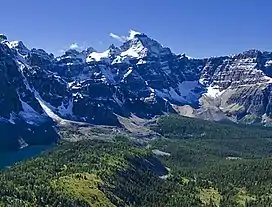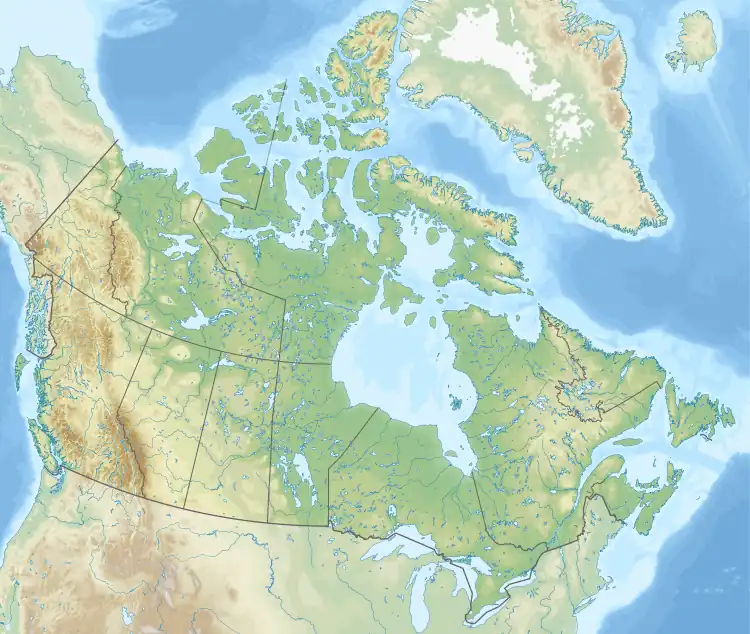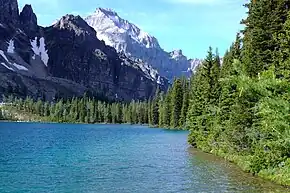| The Marshall | |
|---|---|
 The Marshall seen from Nub Peak | |
| Highest point | |
| Elevation | 3,180 m (10,430 ft)[1] |
| Prominence | 410 m (1,350 ft)[1] |
| Parent peak | Mount Assiniboine (3616 m)[1] |
| Listing | Mountains of British Columbia |
| Coordinates | 50°52′46″N 115°41′37″W / 50.87944°N 115.69361°W[2] |
| Geography | |
 The Marshall Location of The Marshall in British Columbia  The Marshall The Marshall (Canada) | |
| Country | Canada |
| Province | British Columbia |
| District | Kootenay Land District |
| Protected area | Mount Assiniboine Provincial Park |
| Parent range | Park Ranges ← Canadian Rockies |
| Topo map | NTS 82J13 Mount Assiniboine[2] |
| Geology | |
| Age of rock | Cambrian |
| Type of rock | sedimentary rock |
| Climbing | |
| First ascent | 1919 V.A. Fynn, Rudolph Aemmer[1] |
| Easiest route | Scramble[1] |
The Marshall is a 3,180-metre (10,430-foot) mountain summit located in Mount Assiniboine Provincial Park, in the Canadian Rockies of British Columbia, Canada. Its nearest higher peak is Mount Assiniboine, 3.0 km (1.9 mi) to the east-southeast.[1] The mountain is situated west of Wedgwood Peak.
History
The mountain was named in 1913 by the Interprovincial Boundary Survey due to its "leading" position.[3] It was alternately known as Centurion Peak since "centurion" was a Roman commanding officer, synonymous with "Field marshal", a commander of military forces.[4]
The first ascent of The Marshall was made in 1919 by Val Fynn with Rudolph Aemmer as guide.[3]
The mountain's name was officially adopted March 31, 1924, by the Geographical Names Board of Canada.[2]
Geology
The Marshall is composed of sedimentary rock laid down during the Cambrian period. Formed in shallow seas, this sedimentary rock was pushed east and over the top of younger rock during the Laramide orogeny.[5]

Climate
Based on the Köppen climate classification, The Marshall is located in a subarctic climate zone with cold, snowy winters, and mild summers.[6] Temperatures can drop below −20 °C with wind chill factors below −30 °C. Precipitation runoff from The Marshall drains into tributaries of the Mitchell River.
See also
References
- 1 2 3 4 5 6 "The Marshall". Bivouac.com. Retrieved 2019-02-03.
- 1 2 3 "The Marshall". Geographical Names Data Base. Natural Resources Canada. Retrieved 2019-02-03.
- 1 2 "The Marshall]". cdnrockiesdatabases.ca. Retrieved 2021-06-18.
- ↑ "The Marshall". BC Geographical Names. Retrieved 2021-06-18.
- ↑ Gadd, Ben (2008), Geology of the Rocky Mountains and Columbias
- ↑ Peel, M. C.; Finlayson, B. L. & McMahon, T. A. (2007). "Updated world map of the Köppen−Geiger climate classification". Hydrol. Earth Syst. Sci. 11: 1633–1644. ISSN 1027-5606.